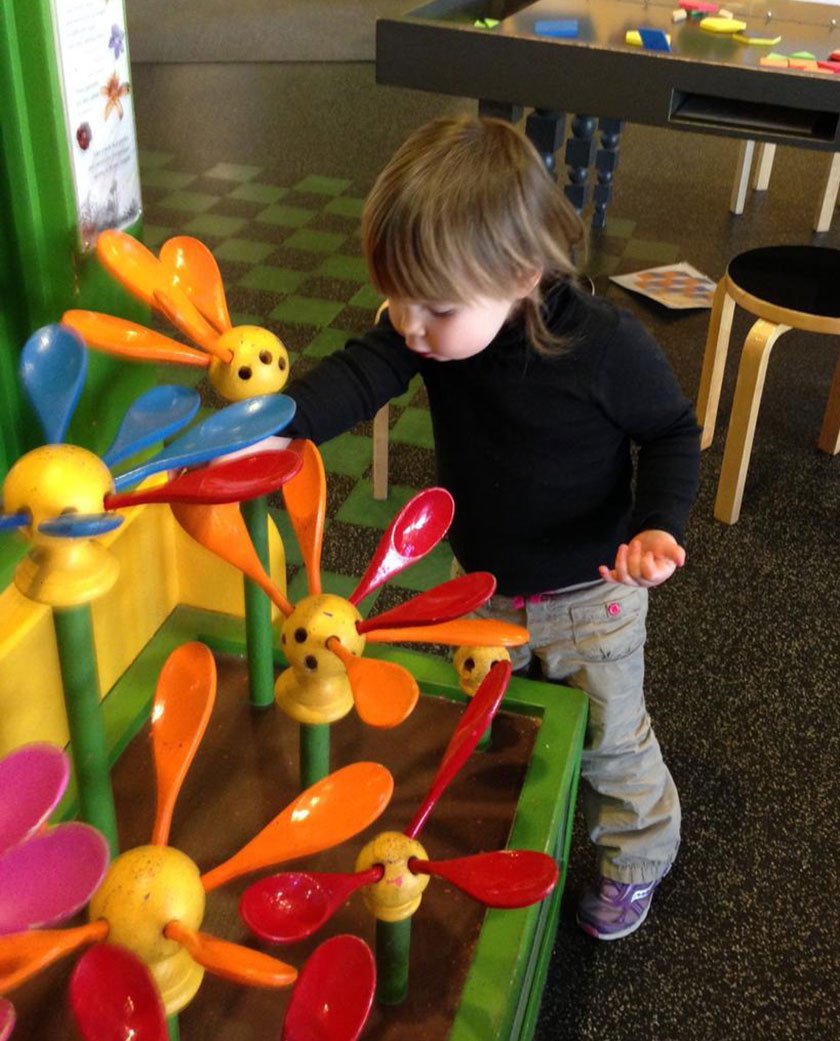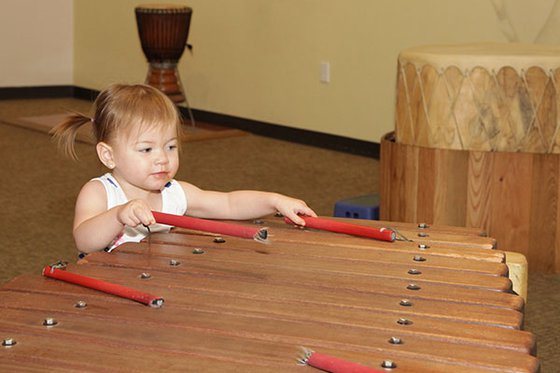Wondering what to do? Keep the tried and true exhibits of TotSpot, Sandy Island and Bubbles part of your visit, but add these to your day's to-do list!
12-18 months
Start your journey at the Museum keeping in mind the concepts of solitary and parallel play. While interaction with other children is generally limited to taking and passing objects between one another, your one-on-one focus as a caregiver provides valuable bonding time. Hop on over to these galleries to explore together:
Pattern Studio
- Play with the hall of mirrors. Your child is finally discovering that other child they see is actually their own reflection!
- Count components as your child hands them to you. One flower petal, two flower petals, three flower petals, etc. Bonus: Children develop fine motor skills as they grasp and manipulate wooden flower petals.
- Point out different colors and shapes you see at the tessellation table. Can you find a match?
KEVA
- Grab a pile of planks to slide off the table and watch as children collect them over and over again.
- Build little towers together, prompting your toddler to pick up more planks or knock over your structure.
- Show your child how to drag and push the crates filled with planks around the room.
Sound Showers
- Move your body quickly or slowly to match the rhythm your child makes on the instruments. Take turns who dances and who plays.
- Support the power of choice by letting your little one pick an instrument to explore, then discover the sound each one makes.
- March in a parade around the room while practicing different forms of movement to the music. Stomp like an elephant, tip toe like a mouse, or fly like a bird.
18-24 months
Repetition is key to education at any age, but it's especially imporant during this phase of language explosion and the cognitive development of thinking and reasoning. Head to any of the galleries above, and give these two a try, too:
Feasts for Beasts
- Identify noses, eyes, mouths, and other body parts of the statues in Animal Diner or illustrations on the walls.
- Explore color as you search for the live White's Tree Frogs in their habitat. Are they green or brown today?
- Take a peek behind the curtain at the real, live observation beehive. Can you find how the bees leave to go outside to get their nectar?
Communication Station
- Explore the communication tools from years past. Can you dial a rotary phone?
- Spin the plates to see animals move through the magic of "persistence of vision."
- Visit the News12 studio where children can become a news anchor or weather person to see themselves on screen.
2 to 3 Years
Pushing the boundaries of independence, older toddlers make it known what they want... and what they don't! Follow their lead and head to whatever catches their eye, making self-guided play the driving force of your day. Let them find exhibit components and observe how they use them. For little ones that need some more guidance, encourage pretend play by becoming a snake in Feasts for Beasts or go fishing in Your House, My House. Experience puzzles in a new way with tessellations in Pattern Studio and find new concepts in our traveling exhibit on the first floor. Give your child the opportunity to show you how they see the world.

Explore objects in a new context, expose children to new vocabulary by narrating what you're seeing and allow children to generate their own ideas for how things work. It's all part of the process of developing young minds.
For the Parents
As an informal gathering space, the Museum is a community location to meet other caregivers. Share parenting experiences, enjoy adult interaction and take the opportunity to model getting out and about for your own children.
What about Infants?
While children under age one are free of charge, babies in arms and crawlers benefit from early introduction to new experiences.
- Build upon an infant's growing understanding of depth perception by holding them close to artwork in our Community Gallery.
- Play peek-a-boo or hide-and-seek with any objects. Can they find a magnetic stamp or magnetic word hidden under your hand in Communication Station?
- Allow crawlers a place to move in Sound Showers - an enclosed gallery with separate spaces, each with its own experience.
- Explore cause and effect in Pattern Studio by spinning the zoetrope and gross motor skills by pulling up on the bricks table.
- Narrate all of the sights and sounds around you to promote vocalization, chatter, and the introduction of new vocabulary not heard regularly in your home.
- Watch other children (including older siblings) for endless entertainment. Never underestimate the importance of smiles and laughter.
A tip from parents: a day of exploration at the Museum leads to longer naps!
